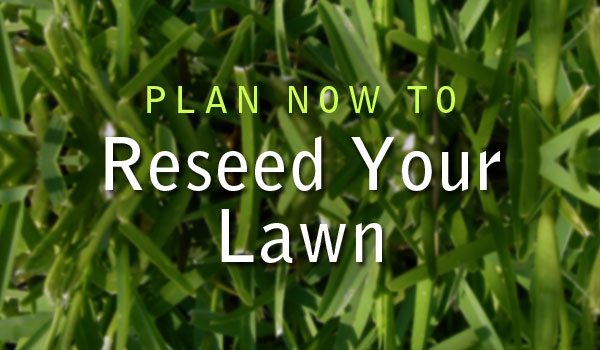Plan Now to Reseed Your Lawn
 Cary, NC – With all the wacky weather this spring and summer, it’s time to plan now to reseed your lawn this autumn.
Cary, NC – With all the wacky weather this spring and summer, it’s time to plan now to reseed your lawn this autumn.
Plan Now to Reseed Your Lawn
In years past, prime reseeding time in the Triangle has been late August or early September. But this year, temperatures have been cooler. If the summer weather pattern continues, reseeding time may be as early as mid-August.
So start your planning now (especially if you have to kill off weeds). That’s why, during our vacation week, we’re re-running this story from August 2011 called Rescue the Fescue.
Lawn Grasses
Fescue is a type of grass that likes cooler weather – it looks best during spring and fall. The time to fix fescue lawns that have been damaged by summer’s heat is coming up.
Another type of lawn grass is Bermuda. It loves hot weather. If your lawn looks great in July but turns golden brown in the winter, you may have Bermuda grass. Other warm-weather grasses include Zoysia, St. Augustine and Centipede.
Rye grass is an annual sown in the autumn that looks great all winter and through spring until the weather turns hot. Rye grass lawns usually need to be re-seeded every year.
Rescue the Fescue
Many things can damage a fescue lawn during the heat of summer including drought, fungus, too much rain, weeds and bugs.
Does your lawn look stressed right about now? Got brown patches or weeds? A few bare spots? Now is the time to plan your lawn repair.
1. Kill the Weeds – The first step to rejuvenating your fescue lawn is to kill the summer weeds. Your local gardening store can recommend a product that nukes the weeds but won’t harm the grass. This is of course assuming that your lawn isn’t ALL weeds. In that case, you’ll have to nuke it all. Best to start now with the weed killer so you’ve got a couple of weeks for it to take effect before you begin reseeding.
2. Rake off the Lawn – This is the part I hate the most. No machine does it as well as just grabbing a rake and scraping all the odd bits of business off the lawn. Try to get as much thatch – tangled mats of dead grass – off as you can. The idea is to expose the soil so the new seeds can make contact with the dirt.
3. Soil Amendments – Once you’ve killed the weeds and raked off anything dead or tangled, it’s good to sprinkle around some soil amendments. This is the step most people forget or neglect but it makes a big difference over time. Carolina Piedmont soil like we have in Cary is predominantly clay. It’s dense and usually a little on the acidic side. Get a bag or two of gypsum to lighten up the soil and a bag of Lime as well. Lime “sweetens” the soil, bringing down the acidity or pH. You can use a seed broadcaster to distribute the lime and gypsum evenly over the lawn or just walk around flinging handfuls. The broadcaster is a lot less work.
4. Aerate – Few homeowners own a soil aerator. But the local garden supply stores will rent one to you. It looks a little like a tiller but has sharp tubes to punch holes in the soil instead of blades to chop it all up. Aerators are pretty frightening machines, big and powerful. Wear sturdy shoes and proper safety gear. Aerate your soil evenly across the lawn. One pass is adequate but two even better. If you are remaking your entire lawn, use a tiller and till the entire area finely.
5. When to Seed – Once you have the lawn prepared, it’s time to think about seeding. The latter part of August is usually a good time to get this done. Although the air may still be hot, the soil is beginning to cool down due to the shorter daylight hours. By September, fescue lawns are growing like crazy, homeowners are once again cutting their grass every week and you want your new seeds to be growing.
6. Mow Short – When you’ve decided on a date to seed, cut the grass short. Give the lawn a good watering – this will help the seeds stick and promote deep roots.
7. Seeding – You need to use a seed broadcaster to ensure even distribution. A handheld broadcaster is inexpensive and will get the job done unless you have a very large property. Push broadcasters take less time to cover large areas. New lawns will need far more seed than existing lawns. For bald patches, rough up the dirt a little bit, lay down the seed and then cover with hay straw. Ask at the garden store for the best type of fescue seed to buy for your individual conditions – how much sun, shade, water, slope. Scientists have engineered lots of kinds of fescue designed to cope with various lawn problems. You could even bring in a grass sample and they might be able to match it. In my lawn, there are several kinds of fescue all mixed together.
8. Watering – After seeding, you need to wet down the lawn so the seeds don’t blow away or wash away.. Since you’ve already deep watered, this is just a surface shpritz, like a gentle rain shower. You’ll have to keep the surface damp for a week to ten days. Once you see the seeds sprouting, you can cut back to every other day, then every third day and so on until you get back to your normal routine.
9. Mowing – Finally, your new grass is growing tall. Probably by now, your existing grass is getting a tad overgrown. It’s time to give your new lawn a mowing. Use a bagger so the clipped grass doesn’t smother the new shoots. Avoid the patches you’ve fixed. The idea is to allow light and air to circulate without ripping out the new grass before it can grow strong roots. It’s a judgement call. I usually let my existing turf grow to about four inches before mowing a lawn I’ve just seeded. Depending upon the time of year, that can be three or four weeks after seeding.
————————————————————————————————
July 27 – August 3 is vacation week for CaryCitizen. All week, we’ll be re-running some our most popular stories from the past four years. Photo by CameliaTWU.


